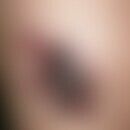Synonym(s)
HaT; heparin-associated thrombocytopenia; heparin-induced thrombocytopenia; Heparin necrosis; HIT; white clot syndrome
DefinitionThis section has been translated automatically.
Decrease in the number of blood platelets (thrombocytes) after systemic application of heparin.
ClassificationThis section has been translated automatically.
- Heparin-induced thrombocytopenia type I (non-immunological): reduction of platelet count in the early phase of treatment. The decrease in platelet count is significantly less than 50%, but without progression despite continuation of treatment with heparin.
- Heparin-induced thrombocytopenia type II (immunological).
You might also be interested in
Occurrence/EpidemiologyThis section has been translated automatically.
Occurs in about 1-5% of cases during treatment with unfractionated heparin. In treatment with low-molecular-weight heparin, occurrence in < 1% of cases.
EtiopathogenesisThis section has been translated automatically.
- In HIT II, a heparin-induced antibody binds to the IgG-Fc receptor of the thrombocytes and leads to platelet activation. Consecutively, procoagulatory microparticles are generated. In addition, platelet proteins (platelet factor 4) are released, which neutralize free heparin. These platelet proteins bind to heparan sulfate, which is present in the endothelial cell membrane. The complex attaches the autoantibodies and thereby activates the endothelial cells, which increases thrombin formation and finally results in thrombocytopenia. There is a risk of loss of extremities through thrombotic events. There is also a potential danger to the patient's life!
- The occurrence of HIT II depends on the duration and dose of the heparin treatment as well as on the molecular size of the active substance. Longer-chain, unfractionated heparin has a two to three times higher risk of HIT II than low molecular weight heparin.
ClinicThis section has been translated automatically.
- Initially succulent, red-blue to blue-black, painful spots that can develop into extensive plaques. Formation of hemorrhagic blisters possible.
- In about 40% of cases, arterial or venous vessel occlusion (also known as white-clot syndrome ) occurs.
- Note: the HIT can be estimated by the 4T-score: thrombocytopenia, timing, thrombosis and other causes of thrombocytopenia.
LaboratoryThis section has been translated automatically.
- Detection of antibodies against platelet factor 4-heparin complex by ELISA.
- Performance of a HIPA test.
- Regular laboratory controls.
HistologyThis section has been translated automatically.
Hemorrhagic infarctions of small and medium-sized vessels of the entire dermis. Infarctions also of single vessels of the subcutis.
Differential diagnosisThis section has been translated automatically.
Complication(s)(associated diseasesThis section has been translated automatically.
Development of mostly extensive, red-blue bordered, deep, dolent ulcers. More rarely are maculo-papular exanthema.
TherapyThis section has been translated automatically.
- Heparin-induced thrombocytopenia type I: self-limiting course with continuation of heparin therapy; spontaneous regression of thrombocytopenia within a few days
- Heparin-induced thrombocytopenia type II: immediate discontinuation of heparin; alternatively, if there is an indication for anticoagulation, treatment should be continued with either the heparinoid danaparoid sodium (Orgaran) or the recombinant hirudin preparation lepirudin (refludan; 0.4 mg/kg bw as a bolus, then continuous infusion 0.15 mg/kg bw).
- If necessary, argatroban (synthetically produced direct thrombin inhibitor) initially 0.5-2 µg/kg bw/min. i.v.; regular laboratory checks!
Note(s)This section has been translated automatically.
Remember! Any platelet drop to less than 50% of the initial value or to absolute values < 100,000 platelets/µl must always be considered as heparin-induced thrombocytopenia type II until proven otherwise!
LiteratureThis section has been translated automatically.
- Greinacher A et al (2003) Heparin-induced thrombocytopenia. Dtsch Ärztebl 100: 2220-2229
- Greinacher A et al (1991) A rapid and sensitive test for diagnosing heparin-associated thrombocytopenia. Thromb haemost 66: 734-736
- Helbig D et al (2007) Skin and mucosal ulcerations in heparin-induced thrombocytopenia (HIT II). Dermatologist 58: 774-778
- Warkentin TE et al (2006) Gender imbalance and risk factor interactions in heparin-induced thrombocytopenia. Blood 108: 2937-2941
Incoming links (11)
Argatroban; Coumarin necrosis; Danaparoid; Heparin allergy; Heparin necrosis; Hipa test; Hirudin; Hit; Lepirudin; Renal replacement treatment; ... Show allOutgoing links (9)
Coumarin necrosis; Disseminated intravascular coagulation; Elisa; Heparin; Heparin-induced thrombocytopenia; Hipa test; Lepirudin; Platelet factor 4; Purpura idiopathic thrombocytopenic;Disclaimer
Please ask your physician for a reliable diagnosis. This website is only meant as a reference.





